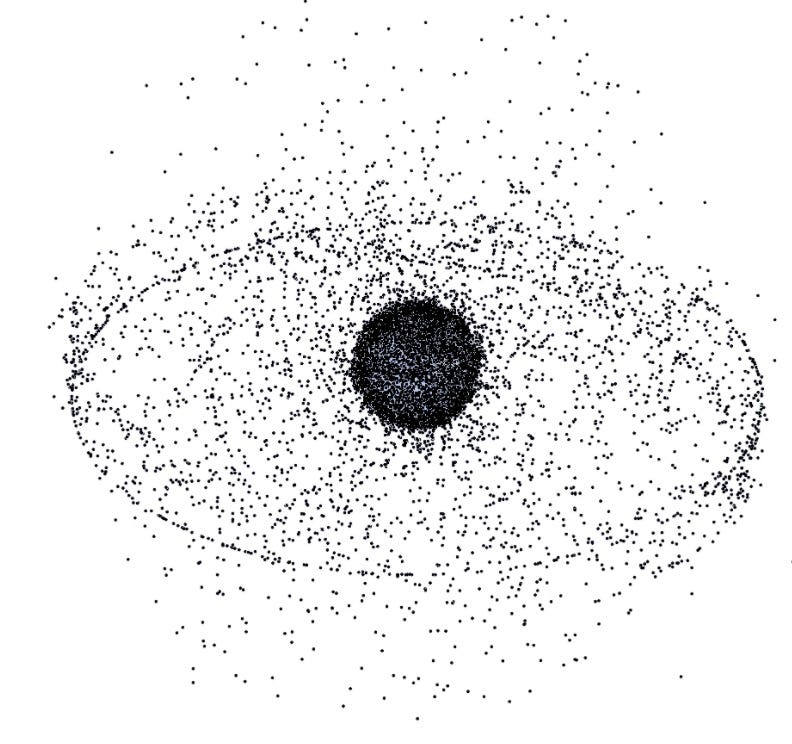Satellite pollution: The final frontier is getting crowded
Thousands of new satellites are planned to meet the world's hunger for better Internet connections. Are we ready for the, uh, fallout?

This model image from NASA shows orbital debris, or “space junk,” from the perspective of high-Earth orbit.
By Michael Molinski
(Michael Molinski is a senior economist at Trendline Economics. He’s worked for Fidelity, Charles Schwab and Wells Fargo, and previously as a foreign correspondent and editor for Bloomberg News and MarketWatch.)
PLAYA DEL REY, Calif. (Callaway Climate Insights) — Imagine a world where the sky is so full of satellites that they bump and crash into each other, knocking out your Internet or cellphone service and your TV signals, not to mention the weather and climate satellites that meteorologists use to bring reports of the weather, and monitor sea levels and hurricanes.
Oh, and dangerously dropping wreckage and debris across the planet. Buckle up, because if the commercial satellite launchers get their wish, that day may not be far off.
The European launch company OneWeb announced in late May it filed plans with the U.S. Federal Communications Commission to launch 48,000 satellites in low-Earth orbit, adding to the 42,000 satellites that SpaceX is already planning through part of its Starlink program. Russia, China, India and other countries are planning satellites of their own.
OneWeb has launched 74 satellites. The London-based company went bankrupt in March. Recently, a consortium led by the British government agreed to take a $500 million stake in OneWeb. SpaceX has launched 422 Starlink satellites into orbit since 2019. Tesla (TSLA) CEO Elon Musk is also CEO of SpaceX.
Right now, there are about 5,000 satellites in orbit around the earth, up from just 160 in 1984. The first satellite, Sputnik, was launched by the Soviet Union in 1957.
Why is satellite congestion a problem?
The chance of two satellites crashing into each other now is slim, but it has happened. Last year, the European Space Agency was forced to reprogram one of its satellites to avoid running into a SpaceX satellite. There have been only four collisions in space between two satellites, with the most famous being when an Iridium Communications satellite collided with Russia’s Kosmos satellite in 2009.
If any satellites collide with each other, in most cases the effects would probably not be crucial. You may temporarily lose your Internet or TV service, or if it’s a government or military satellite it would simply mean that spying couldn’t be conducted.
However, three-quarters of the data used in numerical weather prediction models and climate change depend on satellite measurements. There are currently 18 geostationary satellites positioned above the equator, and another 17 that are polar-orbiting weather satellites. These 35 satellites combine their data from around 160 or so environmental satellites to forecast the weather and climate change.
“These satellites provide atmospheric measurements, the level of aerosols and greenhouse cases in the atmosphere, monitor the ozone layer, energy capture, atmospheric humidity, temperature (typically by aid of infrared and microwave sounders) and atmospheric winds, as well as measuring cloud cover density, identifying the cloud types and studying cloud particle properties, monitoring of volcanic ash plumes and other particles entering the atmosphere,” said a report by the Organization for Economic Cooperation and Development.
Knocking out just one of those satellites could have drastic effects to climatologists’ predictive capacity.
To be sure, studies show that the debris in the geostationary orbit near 36,000 km — where telecom and meteorological spacecraft operate — is much less crowded than it is in low-Earth orbit, where commercial satellites operate, at an altitude of less than 2000 km, according to NASA’s Orbital Debris Program Office. “Since the geostationary orbit is a special natural resource, many spacecraft operators boost their old spacecraft into higher, disposal orbits at the end of their mission,” NASA says.
Commercial losses
There are two things that the makers and launchers of satellites are worried about.
First, the day may come when governments require them to decommission and remove their satellites from orbit, and second, while the chance of crashing into another satellite is slim, of much more concern is the emerging problem of “spectral congestion,” where too many satellites and ground stations are sending out too many electromagnetic signals which can interfere with one another.
Both are issues that engineers and corporate management are wrestling with, from satellite launchers like SpaceX and OneWeb to satellite manufacturers like Lockheed Martin (LMT), Airbus and Boeing Co. (BA).
“As demand escalates for fast, reliable internet around the world, especially for those where connectivity is non-existent, too expensive or unreliable, SpaceX is taking steps to responsibly scale Starlink’s total network capacity and data density to meet the growth in users’ anticipated needs,” SpaceX said in a statement.
Removing a satellite from orbit is not an easy thing, which is why up until now satellite launchers have just left their satellites where they are, circumnavigating the earth in perpetuity, years after they have served their initial purpose.
NASA, in a September 2018 report, recommended that all future satellites be taken out of orbit as soon as they complete their mission. So far, the FCC has not required that. To remove a satellite, the operators would need to lower the satellite’s orbit to where it would hit the earth’s atmosphere and disintegrate into small pieces of debris.
Of the estimated 5,000 satellites currently in orbit, only about 1,800 are operational.
Both SpaceX and OneWeb declined comment on the potential costs of reprogramming the satellites if that were to be the case.
Right now, though, satellite manufacturers seem more concerned about the second issue of spectral congestion, where hordes of electronic engineers and computer scientists are scrambling to protect their electromagnetic signals and to prevent overlap with someone else’s signals — an area that is popularly referred to as “electronic warfare.”
